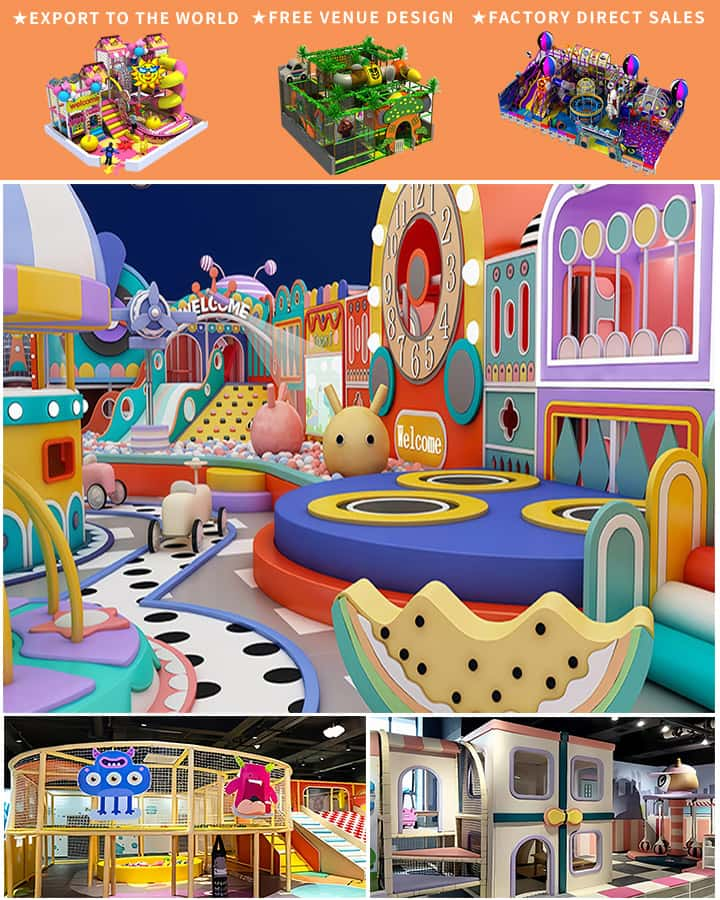In today’s competitive market, creating a unique and engaging indoor playground can set your business apart from the rest. An indoor playground not only provides children with a safe and fun environment but also offers parents a convenient spot to relax. Here are some innovative ideas to help you design an indoor playground that will attract families and keep them coming back.
1. Themed Adventure Zones
Themed play areas can captivate children’s imaginations and provide immersive experiences. Consider creating zones based on popular themes such as pirate adventures, jungle safaris, or space exploration. Incorporate elements like themed decorations, background music, and interactive installations to enhance the experience.
Example:
- Pirate Adventure: Include a shipwreck-themed climbing structure, a treasure chest slide, and interactive games where kids search for hidden treasures.
- Jungle Safari: Use greenery, faux animals, and log structures to create a safari-like atmosphere. Add a small water feature for splashing fun.
2. Educational Play Areas
Combine fun with learning by incorporating educational elements into your playground. These areas can include interactive exhibits, puzzles, and games that promote cognitive and motor skill development.
Example:
- Science Corner: Set up a mini laboratory with simple experiments like building bridges, exploring magnets, and conducting safe chemical reactions.
- Math Playground: Create giant outdoor chessboards, number hopscotch, and counting walls to make math enjoyable and interactive.
3. Multi-Sensory Playgrounds

Engage all the senses with multi-sensory play areas designed to stimulate sight, sound, touch, and even smell. These sensory-rich environments can be especially beneficial for children with sensory processing needs.
Example:
- Textured Slides: Use materials like rubberized fabric, sandpaper, or foam to create textured surfaces on slides and tunnels.
- Sound Maze: Install musical instruments, bells, and chimes along a path where kids can explore different sounds as they walk through.
4. Customizable Play Spaces
Allow for flexibility and creativity by incorporating customizable play spaces where children can build their own adventures. Modular play structures, movable obstacles, and adjustable equipment can offer endless possibilities.
Example:
- Build-Your-Own Fort: Provide cushions, blankets, and lightweight blocks that kids can use to construct their own forts or castles.
- Interactive Walls: Install large whiteboard walls where children can draw, write, or play educational games with magnetic pieces.
5. Tech-Integrated Fun Zones
Incorporate modern technology to create interactive and dynamic play areas. AR (Augmented Reality) games, interactive projections, and digital scavenger hunts can add a futuristic twist to traditional playgrounds.
Example:
- AR Treasure Hunt: Use augmented reality apps to create virtual treasure hunts around the playground, encouraging kids to find hidden gems using their smartphones or tablets.
- Interactive Projections: Project games and animations onto floors and walls, allowing kids to interact with the images using motion sensors.
6. Tranquil Recreational Spaces
While high-energy play is essential, don’t forget to offer tranquil areas where kids and parents can relax. These spaces can include reading nooks, soft play mats, and quiet activity tables.
Example:
- Reading Corners: Set up cozy reading nooks with bean bags, bookshelves, and ambient lighting to create a calm atmosphere for storytelling and quiet reading.
- Mindfulness Garden: Design a small indoor garden with plants and gentle water features where children can practice mindfulness activities like yoga or deep breathing exercises.
7. Seasonal and Holiday Themes
Keep the playground fresh and exciting by rotating themes according to seasons and holidays. This approach ensures that repeat visitors always have something new to enjoy.
Example:
- Winter Wonderland: During winter, transform the playground into a snowy landscape complete with faux snow, ice-themed decorations, and holiday music.
- Spooky Halloween: In October, create a haunted house or spooky maze with friendly ghosts, spiders, and pumpkins.
Conclusion
Designing an exceptional indoor playground requires creativity, planning, and a focus on both fun and safety. By incorporating diverse themes, educational elements, sensory experiences, and modern technologies, you can create a thriving business that delights children and satisfies parents. Remember, the key is to keep the experience fresh, engaging, and inclusive for all ages and abilities. Happy playing!




